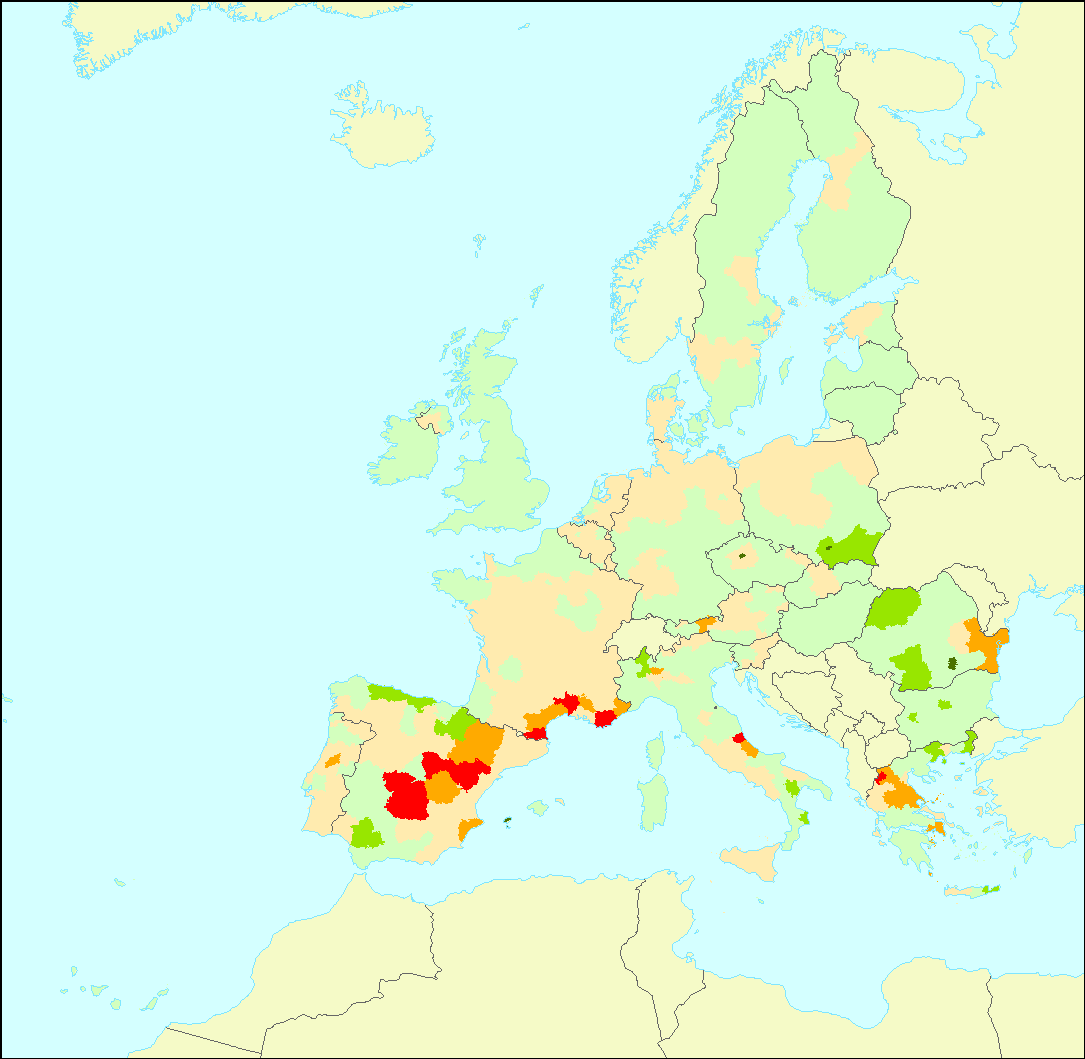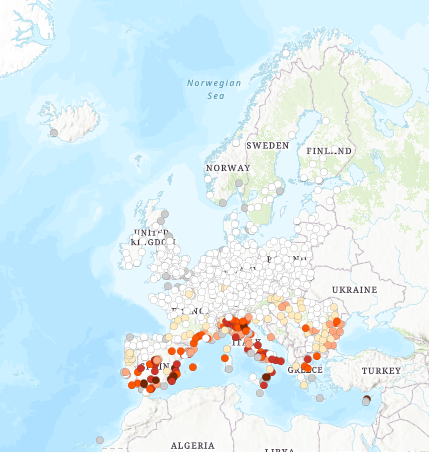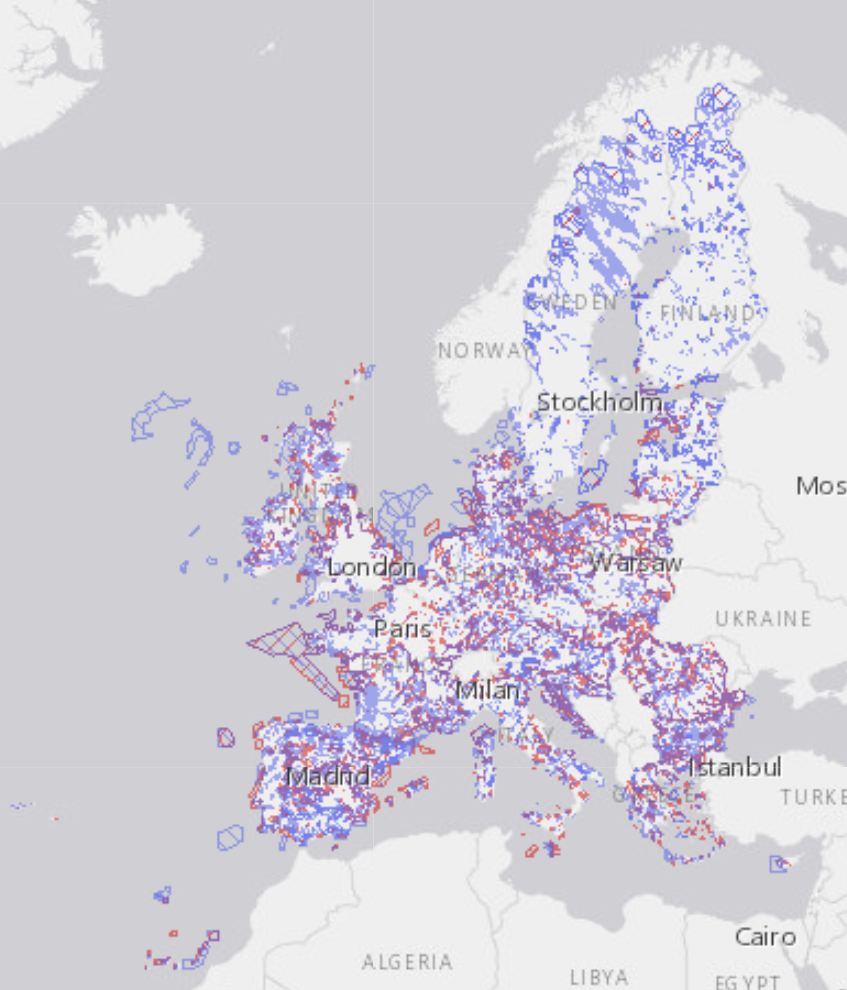EU28 (2013-2020)
Type of resources
Available actions
Topics
INSPIRE themes
Keywords
Contact for the resource
Provided by
Years
Formats
Representation types
Update frequencies
status
Scale
Resolution
-

Natura 2000 is an ecological network composed of sites designated under the Birds Directive (Special Protection Areas, SPAs) and the Habitats Directive (Sites of Community Importance, SCIs, and Special Areas of Conservation, SACs). The European database on Natura 2000 sites consists of a compilation of the data submitted by Member States to the European Commission. This European database is generally updated once per year, so as to take into account any updating of the content of the national databases by Member States. However, the release of a new EU-wide database does not necessarily entail that a particular national dataset has recently been updated. The descriptive data in the European database are based on the information that national authorities have submitted, for each of the Natura 2000 sites, through a site-specific standard data form (SDF). Amongst other site-specific information, the standard data form provides the list of all species and habitat types for which a site is officially designated. The spatial data (borders of sites) submitted by each Member State are validated by the European Environment Agency (EEA), including as regard their consistency with the descriptive data. Any problems identified through the above validation procedures in the national datasets are brought to the attention of the Member States concerned. However, it remains up to the Member States to decide whether or not to submit a revised dataset before the European database is updated. As a consequence, the EEA cannot guarantee that all inconsistences detected in national datasets are removed in the European dataset. Please note that some Member States have submitted sensitive information that has been filtered out of this database. The following Member States have submitted sensitive information: Austria, Finland, France, Germany, Ireland, Italy, Latvia, Luxembourg, Poland, Spain and Sweden. This concerns mainly species associated to specific sites. All reference to these species has been removed from the related sites. If this sensitive information is necessary to your field of research, please contact the Member States' administrations individually. You can find a compiled list of national or regional Natura 2000 websites at the following address: http://ec.europa.eu/environment/nature/natura2000/db_gis/index_en.htm#sites There are specific terms and conditions relating to the use of downloaded boundary data within the United Kingdom. If you intend to use the UK data you must first agree to the end user licence http://www.jncc.gov.uk/page-5232.
-

The Common Database on Designated Areas (CDDA) is more commonly known as Nationally designated areas. It is the official source of protected area information from European countries to the World Database of Protected Areas (WDPA). The inventory began in 1995 under the CORINE programme of the European Commission. It is now one of the agreed Eionet priority data flows maintained by EEA with support from the European Topic Centre on Biological Diversity. The CDDA data can be queried online in the European Nature Information System (EUNIS). Geographical coverage of GIS vector boundary data: Albania, Austria, Belgium, Bosnia and Herzegovina, Bulgaria, Croatia, Cyprus, Czech Republic, Denmark, Estonia, Finland, France, Germany, Greece, Hungary, Iceland, Ireland, Italy, Kosovo under UNSC Resolution 1244/99, Latvia, Liechtenstein, Lithuania, Luxembourg, the North Macedonia, Malta, Montenegro, the Netherlands, Norway, Poland, Portugal, Romania, Serbia, Slovakia, Slovenia, Spain, Sweden, Switzerland and United Kingdom. EEA does not have permission to distribute some or all sites reported by Estonia, Ireland, Romania and Turkey. When re-using the data, copyright is to be mentioned specifically for Estonia and for Finland: "Estonian Environmental Register 01.01.2017; "©Finnish Environment Institute, 2017".
-

The European inventory of Nationally designated areas (CDDA) holds information about designated areas and their designation types, which directly or indirectly create protected areas. The inventory is delivered by the Eionet partnership countries as spatial and tabular information. The inventory began in 1995 under the CORINE programme of the European Commission. The CDDA is now an agreed annual Eionet core data flow maintained by the European Environment Agency (EEA) with support from the European Topic Centre on Biological Diversity (ETC/BD). The dataset is used by the EEA and e.g. the UNEP-WCMC for their main European and global assessments, products and services. The CDDA is the official source of protected area information from the 39 European countries to the World Database of Protected Areas (WDPA). The CDDA data can be queried online in the European Nature Information System (EUNIS). Geographical coverage of GIS vector boundary data: Albania, Austria, Belgium, Bosnia and Herzegovina, Bulgaria, Croatia, Cyprus, Czech Republic, Denmark, Estonia, Finland, France, Germany, Greece, Hungary, Iceland, Ireland, Italy, Kosovo under UNSC Resolution 1244/99, Latvia, Liechtenstein, Lithuania, Luxembourg, North Macedonia, Malta, Montenegro, the Netherlands, Norway, Poland, Portugal, Romania, Serbia, Slovakia, Slovenia, Spain, Sweden, Switzerland and United Kingdom. EEA does not have permission to distribute some or all sites reported by Estonia, Finland, Ireland and Turkey. Two versions of the dataset are provided. The "CDDA_2018_v01_public_EuropeEPSG3035" version includes only continental Europe, i.e. excludes the overseas entities. The full dataset ("CDDA_2018_v01_public") includes the entire geographical coverage including nationally designated areas in overseas entities. Both versions are provided in GDB and GPKG formats.
-

A 10m high resolution raster layer containing height information is generated for core urban areas of selected cities (capitals in EU28 + EFTA) as part of the Urban atlas. Height information is based on IRS-P5 stereo images and derived datasets like the digital surface model, the digital terrain model and the normalized DSM.
-

The dataset represents a measure of intensification trend of agroecosystems. Nutrient input is a specific measure related to the intensification processes in the management of grassland ecosystems. The average change rate of nutrient input between 2005 and 2010 is used to show these tendencies in the NUTS regions (NUTS3 and NUTS2 for Germany). The data comes from the EEA draft nutrient accounts, developed by EEA and ETC/ULS, and is based on spatial reference data on crop and livestock distribution, yield and livestock statistics, and official conversion factors.
-

The dataset presents average values of the number of days per year where the maximum temperature has exceeded 35 degrees Celsius from the period 1987- 2016, for a series of individual European cities from Eurostat's Urban Audit 2011-2014 spatial dataset. The associated values are based on the E-OBS dataset from the EU-FP6 project ENSEMBLES (http://ensembles-eu.metoffice.com) and around 10,000 meteorological stations across Europe. This dataset has been used also in the EEA Report No 22/2018 "Unequal exposure and unequal impacts: social vulnerability to air pollution, noise and extreme temperatures in Europe" (https://www.eea.europa.eu/publications/unequal-exposure-and-unequal-impacts/at_download/file).
-

The new urban sprawl metric, named "Weighted Urban Proliferation“ (WUP) is based on the following definition of urban sprawl: the more area is built over in a given landscape (amount of built-up area) and the more dispersed this built-up area is in the landscape (spatial configuration), and the higher the uptake of built-up area per inhabitant or job (lower utilisation intensity in the built-up area), the higher the degree of urban sprawl. Weighted Urban Proliferation (WUP) metric has three components: the percentage of built-up areas (PBA), the dispersion of the built-up areas (DIS), and land uptake per person (LUP). Besides WUP and its components, the other indicator was calculated: Utilisation Density (UD). UD measures the number of people living and working per km2 of built-up area.
-

The dataset presents the average number of combined hot days - with maximum temperature over 30 degrees Celsius - and tropical nights - with minimum temperature over 20 degrees Celsius - in the period 1987-2016, for a series of individual European cities from Eurostat's Urban Audit 2011-2014 spatial dataset. The associated values are based on the E-OBS dataset from the EU-FP6 project ENSEMBLES (http://ensembles-eu.metoffice.com) and around 10,000 meteorological stations across Europe. The combination of hot days and warm nights is particularly dangerous to human health, as the high temperatures during night time does not allow for the cities and buildings to cool down. Such combination, if lasting over several days (heatwaves) can have severe health implications or even be fatal to the elderly, babies or those in poor health. Therefore, the knowledge of the occurrence of such conditions in a given location can be useful in planning adaptation to the changing climate and protection of the vulnerable groups from heat. This dataset has been used also in the EEA Report No 22/2018 "Unequal exposure and unequal impacts: social vulnerability to air pollution, noise and extreme temperatures in Europe" (https://www.eea.europa.eu/publications/unequal-exposure-and-unequal-impacts/at_download/file).
-

Natura 2000 is the key instrument to protect biodiversity in the European Union. It is an ecological network of protected areas, set up to ensure the survival of Europe's most valuable species and habitats. Natura 2000 is based on the 1979 Birds Directive and the 1992 Habitats Directive. This version covers the reporting in 2019. Natura 2000 is an ecological network composed of sites designated under the Birds Directive (Special Protection Areas or SPAs) and the Habitats Directive (Sites of Community Importance or SCIs, and Special Areas of Conservation or SACs). The European database of Natura 2000 sites consists of a compilation of the data submitted by the Member States of the European Union. This European database is generally updated once a year to take into account any updating of national databases by Member States. However, the release of a new EU-wide database does not necessarily mean that a particular national dataset has recently been updated. The descriptive data in the European database are based on the information that national authorities have submitted, for each of the Natura 2000 sites, through a site-specific standard data form (SDF). In addition to other site-specific information, the standard data form provides the list of all species and habitat types for which a site is officially designated. The spatial data (outlining the boundaries of sites) submitted by each Member State are validated by the European Environment Agency (EEA). Any problems identified through the above validation procedures in the national datasets are brought to the attention of the Member States concerned. However, it remains up to the Member States to decide whether to submit a revised dataset before the European database is updated. The EEA therefore cannot guarantee that all inconsistences detected in national datasets are removed in the European dataset. Please note that some Member States have submitted sensitive information that has been filtered out of this database. The following Member States have submitted sensitive information: Austria, Belgium, Cyprus, Estonia, Finland, France, Germany, Ireland, Italy, Latvia, Lithuania, Luxembourg, Malta, Poland, Portugal, Slovakia, Spain, Sweden and United Kingdom. This concerns mainly species associated to specific sites. All reference to these species has been removed from the related sites. If this sensitive information is necessary to your field of research, please contact the Member State administrations individually. You can find a compiled list of national or regional Natura 2000 websites at the following address: http://ec.europa.eu/environment/nature/natura2000/db_gis/index_en.htm#sites There are specific terms and conditions relating to the use of downloaded boundary data within the United Kingdom. If you intend to use the UK data, you must first agree to the end-user licence http://www.jncc.gov.uk/page-5232. Besides the web service link provided in the metadata, the following services provide information on species and habitat types inside the Natura 2000 sites: https://bio.discomap.eea.europa.eu/arcgis/rest/services/ProtectedSites/Natura2000Habitats/MapServer https://bio.discomap.eea.europa.eu/arcgis/rest/services/ProtectedSites/Natura2000Species/MapServer NOTE: The dataset has been corrected in June 2020 and the files uploaded on the SDI on 30 July 2020. Files downloaded before that date has one invalid site type code (G) that was corrected (to B) in June.
-

The dataset contains information on the European river basin district sub-units delineated for the 1st River Basin Management Plans (RBMP) under the Water Framework Directive (WFD). This data set is available only for internal use of the European Commission and the European Environment Agency. Please search for "PUBLIC VERSION" in the dataset title to access the publicly available version. The information was reported to the European Commission under the Water Framework Directive (WFD) reporting obligations. The spatial data reported under the WFD reporting obligations includes river basin districts, sub-units, surface water bodies, groundwater bodies and monitoring sites. The dataset compiles the available spatial data related to the 1st RBMPs which were due in 2010 (hereafter WFD2010). See http://rod.eionet.europa.eu/obligations/521 for further information on the WFD2010 reporting. It was prepared to support the reporting of the 2nd RBMPs due in 2016 (hereafter WFD2016). See http://rod.eionet.europa.eu/obligations/715 for further information on the WFD2016 reporting. The data reported in WFD2010 were updated using data reported in WFD2016, whenever the spatial objects are identical in 2010 and 2016. For WFD2010 objects, some information may be missing, if the objects no longer exist in the 2nd River Basin Management Plans, and were not reported in WFD2016. This dataset updates the information published in "WISE River basin districts subunits (RBDSU) - version 1.4, Jun. 2011" (https://sdi.eea.europa.eu/catalogue/srv/eng/catalog.search#/metadata/7bd28405-0f3f-4737-830a-ee80762c6aaf). Relevant concepts: River basin district: The area of land and sea, made up of one or more neighbouring river basins together with their associated groundwaters and coastal waters, which is the main unit for management of river basins. River basin: The area of land from which all surface run-off flows through a sequence of streams, rivers and, possibly, lakes into the sea at a single river mouth, estuary or delta. Sub-basin: The area of land from which all surface run-off flows through a series of streams, rivers and, possibly, lakes to a particular point in a water course (normally a lake or a river confluence). Sub-unit [Operational definition. Not in the WFD]: Reporting unit. River basin districts larger than 50000 square kilometre should be divided into comparable sub-units with an area between 5000 and 50000 square kilometre. The sub-units should be created using river basins (if more than one river basin exists in the RBD), set of contiguous river basins, or sub-basins, for example. If the RBD area is less than 50000 square kilometre, the RBD itself should be used as a sub-unit.
 RUC Geo-Data catalogue
RUC Geo-Data catalogue